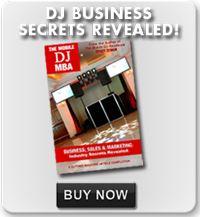 by Bryan Durio (aka Dr. Proof)
by Bryan Durio (aka Dr. Proof)
Part 2 of a 4 Part Series
Attention! You have once again been magically transported back to English class with Dr. Proof, the Grammar Hawk of the DJ industry.
This is Part Two of a four-part series that will give you the know-how to correct all of those verbal and written faux pas you’ve been unknowingly making.
Check your website and marketing materials copy carefully against what you see here, ’cause you may find some wordariffic errors that must be corrected!
Dr. Proof’s Grammar Goof #4: Don’t use quotation marks for emphasis!
We all have seen what would seem to be out-of-place quotation marks around words on signs, flyers, menus, and the like.
Many people laugh at these “emphasis quotes,” because, when read in the ordinary way, they indicate that the word in quotes is not to be taken literally. Just how old is that “fresh” fish, anyway? Is there some hidden cost in that “free” coffee? “Guaranteed,” you say? Where’s the fine print?
Quotation marks are for just that, quoting something or somebody.
If you want to emphasize certain words or phrases, CAPITALIZE them, or use italics or boldface or underlining.
Dr. Proof’s Grammar Goof #5: its or it’s?
This is another error I see all over the place, but it’s easy to avoid if you think of its meaning (pun intended)!
Just remember two points and you’ll never make this mistake again.
1) “it’s” is a contraction meaning “it is” or “it has” and nothing else.
2) Try changing the “its” in your sentence to “his” and if it doesn’t make sense, then go with “it’s”. If it does make sense, you’ve got the right word.
Simple enough? No? Please reread the above until it becomes second nature!
Dr. Proof’s Grammar Goof #6: Commas, Part 1
This will be the Cheat Sheet for comma usage and is by no means an exhaustive tutorial.
The first thing to remember is that the comma often marks a natural pause in the flow of a sentence, and it separates one phrase from another. If you write “I plan to see Shirl and Fred will go shopping while we visit” your readers are naturally going to think the visit will be with both Shirl and Fred until the second half surprises them when they realize that Fred isn’t involved in this visit at all. A simple comma makes everything clear: “I plan to see Shirl, and Fred will go shopping while we visit.” The trouble with commas is that in spoken English, emphasis and rhythm mark out phrases. It takes a conscious effort to translate the rhythm of a sentence into writing using punctuation.
Commas often help set off interrupting matter within sentences. A mild interruption, which is the case most of the time, is nicely set off with commas. Other punctuation used in these cases are parentheses (which we all know), and for fairly strong interjections, dashes-if you know how to use them properly-work best. Many writers don’t realize that they’re setting off a phrase, so they use one comma but forget the second, which should conclude the offsetting word or phrase! For example, “The Best Man, Matt Boone proposed the first toast.”
A standard use for commas is in separating the items in a series: “cats, dogs, and birds.” There is a lot of debate as to whether that final comma before the “and” − called a “serial comma” − is required. I prefer putting the comma in because items in lists can easily be misunderstood and/or confused without one. It often removes ambiguities.
“Comma splices” are mistakenly used where clauses require some stronger punctuation. Here’s an example: “He brought her a dozen roses, he had forgotten she was allergic to them.” In this sentence there are two related but separated ideas, so something stronger, like a semicolon, is needed to break them up: “He brought her a dozen roses; he had forgotten she was allergic to them.” Or just use the conjunction “but”: “He brought her a dozen roses but he had forgotten she was allergic to them.” Here’s a worse example of a comma splice: “It was a beautiful day outside, she remembered in time to grab her coffee mug.” There is no obvious logical connection between the two parts of this sentence, and they don’t belong in the same sentence at all! It should be, “It was a beautiful day outside. She remembered in time to grab her coffee mug.”
Some writers use commas seemingly at random: “The old amp, was used mainly as backup.” When you’re not certain a comma is required, read your sentence aloud. If it doesn’t seem natural to insert a slight pause or hesitation at the point marked by the comma, it probably shouldn’t be there.



